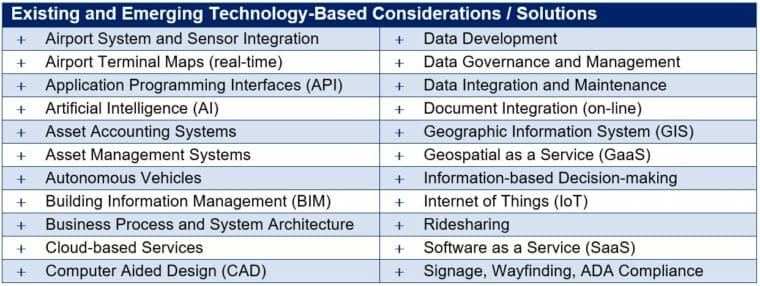Insight | Feb 25, 2020 | Arora
Could Your Digital Foundation Support the Smart Airport of the Future? Part II: Consider the Future
By: Gil Neumann
Where are we going? What will it look like when we get there? Is your airport’s information foundation ready for it? Is your digital data scalable and adaptable enough to serve as building blocks for the “smart airport” future?
Could Your Digital Foundation Support the Smart Airport of the Future?
In our previous Geospatial Practice blog, Arora asked, could your digital foundation support the smart airport of the future?
We discussed The Fourth Industrial Revolution (Industry 4.0) and the ever-changing, tech-centric airport operational and management environments. The future of these domains increasingly relies on understanding how to build bridges to not only harmonize and leverage datasets, but to serve as a standardized platform for improvisation that supports strategic aims and tactical decision-making.
There are several actions airports can take to establish the foundation for the smart airport of the future, including:
- Consider the Future*
- Initiate Collaboration
- Conduct an Assessment
- Build a Roadmap
- Leverage Requirements
* This blog focuses on “Consider the Future,” while subsequent blogs will emphasize additional actions airports can take to solidify its data foundation for the future.
Consider the Future
Smart airports know the value of data and digital technology and position them together to enable better, faster decision making and to improve the customer experience. What is often missed in considering the future is that digital transformation and data utilization is almost entirely incumbent upon organizational change rather than considering and adopting new technologies.
Does data add value to organizational goals and core strategies? Or does it cause confusion and dissension—highlighting rifts between the utilization of different software solutions or challenges with maintaining up-to-date data or adhering to data standards? Moreover, airport technologies come in a dizzying array of formats, packaged as specific or all-encompassing solutions that may or may not work well in the construct of an airport’s business process and operational units.
Whither Digital Literacy?
In considering whether your airport is positioned for the future, it is important to consider foundational elements and direction directly related to the ability of your organization to effectively use information. What follows are questions airport leaders should ask when it comes to digital transformation and the strategic direction for airports and supporting technology.
- Many airport leaders are in the process of guiding digital transformation or strategically positioning to accommodate the ever-present, rapid changes in technology and burgeoning datasets in different formats. Do these strategies include sticking with the traditional Information Technology (IT) department responsibilities of driving standards and scaling automation to existing business processes? Are you a leader legitimately willing to rethink your airport’s digital framework?
- IT departments are often positioned as centralized gatekeepers for enforcing standards and maintaining data across departments. Is your IT department a bottleneck and/or do other departments even bother with following IT standards and processes as they react in the moment to keep their portion of the enterprise operational? Airport leaders should consider whether rethinking the IT department role would better serve its future vision.
- Different airport departments often keep different databases to track activities, leverage resources, or warehouse assets. How much of your airport’s data construct remains compartmentalized? Do those databases include IT data standards? It is likely safe to say that the activity of leveraging data across airport (or local government) enterprises has always been challenging to compartmentalize. Does your airport work across projects or programs and collaborate effectively?
- Working with technology is becoming more routine in almost every function of the operational enterprise. Does your airport include core strategies that focus on the future in concert with digital literacy from top to bottom? Where does your organization stand with respect to the digital literacy of its existing and future employees?
- The distinction between technology developers and users is becoming increasingly blurred. Are you training existing employees to do their jobs with new technology? Are you are hiring the next generation of employees (who are already more exposed to and ingrained in digital transformation than you)? Do your job descriptions reflect the past or the future as it relates to leveraging new ways of doing business?
As technology evolves beyond just being the domain of the IT department, it raises the question of the top leadership—beyond the corporate Chief Information Officer (CIO) or IT Department Director—being capable enough to set a digitally enabled strategy. Because the future requires technology spending that already spreads across the airport domain, every business function leader needs to be engaged with long-term strategies about how they will digitize as part of the enterprise.
What Technologies Should Your Airport Invest In?
To accommodate emerging technologies that have the same “disruptive” potential of their high-tech counterparts in recent past, airports and communities must distinguish solutions from a nebulous series of hardware and software, technical requirements, developing programs, and regulations and standards, while also effectively navigating the demand of fiscal constraints, complex (and sometimes ambiguous) regulations, and transition challenges.
While many options are promising, which ones provide the foundation for an exceptional customer experience and best serve the airport and community for the future? Forward-thinking industry research reveals a variety of existing and emerging technology-based considerations and solutions for airports listed below.

As technology continues to advance, live data is becoming more and more available, which gives governing bodies, financial and infrastructure planners, and data analytics experts the ability to examine events in real-time, to monitor and gain an understanding of patterns and trends, and to respond with thoughtful solutions with the end-user in mind.
For example, real-time sensors are already in use in airport parking structures to show when stalls are occupied or available. Information displays show the number of parking spaces available on parking deck levels—directing drivers to more efficiently accommodate space vacancies and quickly park. This enhances the customer experience, as passengers find themselves in need of quickly parking their vehicles.
So, what can your airport do to ensure its information foundation can meet existing challenges and successfully transform into an agile, provisioned platform that serves potential innovations of the future? If there is one thing past technological advances have taught us, it is that successful organizations are those who are most open to change and who are diligent about making new technologies work for their airport. The foundation for that success is leadership that is willing to drive the change and enable other leaders to adapt quickly while keeping the enterprise in mind.
The information that managers need, in order to make strategic decisions, is often dispersed and context specific. For example, if one department is trying to gather better design data and gauge how operations might be affected or which assets need to be accommodated, it is likely that different experts (inside and possibly outside the airport) hold different pieces of relevant information. It is reasonably easy to gather the perspectives of these experts, using tools designed to aggregate information, and to generate a range of possible outcomes and their probabilities.
Are you aware of these types of tools for your airport? Do you know the right questions to ask when considering the options? For example, is the information available in a centralized manner (enterprise-wide availability) or decentralized (housed in different departments)? If it is decentralized, is your network or project participation base wide enough to tap the experts you need to aggregate their knowledge?
In evaluating the emerging technology-based considerations and solutions for airports above, successful leaders recognize the value of harnessing data for future planning and getting the most from real-time utilization.
By considering several factors, in our estimation the best, immediate short-term solutions for airports include:
- Ensuring airport leadership is completely on board with and active in supporting digital transformation and digital literacy;
- Quickly building a long-term Strategy and Implementation Roadmap based on data, systems, and governance;
- Establishing a strategy that enables data integration, management, and maintenance;
- Leveraging sensor technologies for asset management and maintenance; and
- Leveraging cloud-based solutions and services.
To get the most from an airport’s investments and substantiate the solutions we recommend, there are several factors to consider in choosing technology solutions:
- A Productive User Experience: In an ideal situation, where digital literacy is supported from the top down, airport department management should have the option to do what they want, where they want, when they want, and how they want, without any interruptions in the processes. When it comes to technological solutions, the best way to achieve this is by implementing a “service” platform that offers an intuitive user interface across a range of devices—based on consistency, simplicity, and intelligence—that enables the end user to do their day-to-day tasks efficiently, without having to learn a complex software. A service platform aims to drive increased user productivity and streamline the tasks at hand.
- Progressing Capabilities: In the ever-evolving workplace, it is important to have technology that can change as quickly as the business processes are adjusted, and can react to needs in an “as close to real-time” manner as possible. Cloud-based platforms are designed for scalability to meet growing customer demands as their organization makes changes or requires a quick response. As an organization or department grows and needs additional services from the technology vendor or consultant, new features and functionality can be easily and seamlessly integrated with little to no disruption to the department and/or requiring the IT department to worry about software upgrades or bug fixes. With cloud-based platforms, the vendor or consultant manages regular system updates, ensuring the platform is running smoothly on their end, without interrupting daily processes on the user end of the system. That way, the airport department can stay focused on its goals, rather than worrying about the system or software.
- Accessibility: One of the major benefits of a service platform is that users can access it from anywhere at any time. Not only does this make it easier for airport departments to do what they want, when they want, but it also allows them to grant secure access to employees and other stakeholders on airport-provided devices, or even, in some cases, on their own devices. Additionally, mobile solutions enable airport departments to manage their enterprises when on-the-go, via smart phones or tablets, while configurable desktops or laptops can help create easy-to-use actions and workflows for improved productivity.
- Security: When it comes to an airport’s planning, design, engineering, or construction data, security is a top priority for airport departments. Often, a department’s business information can be better protected in a service solution than in traditional software. Vendors and consultants take extra steps to keep their clients’ data protected and have access to popular data centers and technologies that most small and medium-sized airports or local governments do not. Indeed, many smaller airports find that outsourcing its IT functions to consultants (or hiring them as extension of staff) yields better access to up-to-date security fixes and rapidly changing technology that it could not otherwise keep up with or afford.
- Customer Service: The vendor or consultant-client relationship can make or break the success of a service platform. Questions will inevitably arise during the implementation period and day-to-day use of the system, so it is always a good idea to research vendors’ or consultants’ service models to ensure live help will be available when it is needed. Airport departments should fully research the offerors’ expertise and ensure the platform meets the needs of their responsibilities within the enterprise.



